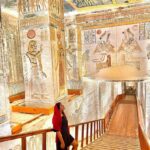10 Natural and Historical Sites in Egypt Most People Have Never Heard Of
We all know that Egypt has tons of visit-worthy natural as well as historical sites (the pyramids, hello!), and because of that it’s easy for some lesser-known ones to fall through the cracks. But just because they’re lesser-known (or not known at all) doesn’t mean they’re not worth experiencing!
So next time you’re interested in learning something new and exploring something off the beaten track, look no further.
10 Natural and Historical Sites in Egypt Most People Have Never Heard Of
1. Djara Cave

Location: Western Desert
Deep in the desert west of Assiut, between the Bahariya and Farafra oases, is a natural wonder millions of years old, that hardly anyone in Egypt has heard of.
We’re talking about the Djara Cave, formed from water coming into contact with the harsh Egyptian desert millennia ago. So many years of chemical activity has left this 30 meter high and 8 meter wide cave full of glittering crystal-like rock formations and stalactites.

If the natural beauty and history of it isn’t enough, Djara Cave has animal engravings on its wall dating back to the Neolithic period, over 10,000 years ago, suggesting that this now barren, remote area was populated at the time. It’s now classified as the second most important Stone Age settlement in the Western Desert, after the Nabta Playa (below).
2. Minya’s City of the Dead (Zawiyyet El-Mayyetin)

Location: Minya
One of the largest cemeteries in the world is Zawiyyet El-Mayyetin, right outside the small Egyptian city of El Minya — hence its moniker as Minya’s City of the Dead. Not only is it impressive in size, but even more so in architecture: a sea of conical domes stretch down the Nile for 4 kilometers (2.5 miles), hugged between a cliff and the river.

The mausolea are made of mud-brick and all are topped with a smooth or stacked dome, and are still used by both Muslims and Coptic Christians until today. This isn’t on any tourist trail, so make sure you have a guide to take you.
3. Catacombs of Kom El Shoqafa

Location: Alexandria
This archaeological site in Alexandria is often overlooked by almost everyone, foreign and Egyptian alike, when visiting this ancient coastal city. These catacombs are a rare mix of Egyptian, Greek and Roman cultural references and are considered one of the Seven Wonders of the Middle Ages.
Dating back to the 2nd century AD, these catacombs are three subterranean levels made out of rock (the deepest level is now totally submerged in water). It was discovered in 1900 when a donkey accidentally fell through the access shaft at ground level (a great discovery, but poor donkey).

The second level of the catacombs is described as “eerily alive” due to all the sculptures there. It’s believed that it was originally intended as a tomb for a single family, but bones of other individuals and horses were also found there.
4. Colored Canyon

Location: Nuweiba
This 800 meter canyon is a part of a larger mountain range, and one of the coolest natural wonders you can see when in the Sinai Peninsula.
These red-hued rock formations are the product of the Red Sea tides residing gradually millions of years ago and eroding these mountains of limestone and sandstone.

You can hike (and sometimes scramble) through the canyon on a dried up riverbed with a Bedouin guide, but it’s not recommended in the summer months due to the scorching sun. The canyon is easily reached from Nuweiba, but you can also arrange trips from Dahab or even Sharm el Sheikh.
5. Crystal clear salt lakes in the desert

Location: Siwa Oasis
Everyone’s heard about Siwa’s hot and cold natural springs, but for some reason Siwa’s arresting aquamarine salt lake doesn’t get as much talk time.
Siwa actually has several salt lakes, which are so salty that they’re known as natural therapy for skin diseases and sinus problems. They’re actually too salty though for any marine life to live in them though, so unfortunately the Siwans can’t use these lakes for fishing.

The lakes vary in size, and some have dried up. But even in the deepest lakes, there’s no real chance of drowning — the buoyancy is similar to the Dead Sea’s.
6. Nawamis

Location: Sinai
Did anyone know that we have mysterious prehistoric circular stone tombs deep in the Sinai desert? Because we sure didn’t.
These circular structures date back to the Copper Age and Early Bronze Age, so they’re around 5,000 to 6,000 years old — meaning they’re between 1,500 to 2,500 years older than the Great Pyramids of Giza, and some archaeologists argue that they’re the oldest free standing structures in the world alongside the Megalithic Temples of Malta and the Cairns of Scotland.

The Nawamis structures are believed to originally be family tombs, due to the bones, beads and other purported funeral offerings found inside. But they were used afterwards by various different desert groups in the centuries that followed, so it’s hard for archaeologists to be quite sure of Nawamis’ original function.
Local tip: the best time to visit Nawamis is in the late afternoon, when the light and shadows play on the structures and their singular doors are illuminated.
7. Ancient hieroglyphic graffiti at Wadi Hammamat

Location: near Qoseir
Ever seen pharaonic graffiti?
The ancient stone quarries of Wadi Hammamat were used by ancient Egyptian engineers and artisans to build monuments, temples and sculptures, and ancient hieroglyphic graffiti from those who would work the quarries can still be seen until present day. There’s also graffiti from the travellers who regularly passed through, due to its popularity as a caravan stop (the Romans had set up watchtowers and wells along the route from the Eastern Desert to Qoseir).

Wadi Hammamat would later be smack dab in the middle of an integral trade route between Arab merchants and Egyptians, and part of the famous Silk Road trade with the Han Dynasty in China.
8. The medieval Islamic town of El Qasr

Location: Dakhla Oasis
Not many know that on the outskirts of the Dakhla Oasis in the western Egyptian desert is a deserted, yet intact, Islamic town that dates back to around the 11th or 12th century, during Ayyubid rule. It’s believed though to be built on the remnants of any even older Roman camp.

It actually isn’t *totally* deserted — it’s estimated that there’s about 700 inhabitants in this otherwise abandoned town, but if they leave, they are not permitted to return, and no new buildings are allowed to be built there so as to safeguard the intact old town as it is.
The empty covered streets, mosques, madrassas and Quranic calligraphy on the buildings still stand today, and some are open to visitors.
9. El Bagawat, one of the oldest Christian cemeteries in the world

Location: Kharga Oasis
The necropolis of El Bagawat in the western desert oasis of Kharga is actually prehistoric — before it was a Christian cemetery, it was a burial ground for non-Christians.
Once Christianity was introduced to Egypt, it became a Coptic cemetery from the 3rd to the 7th century AD. It’s considered one of the oldest and best-preserved Christian cemeteries in the world.

El Bagawat is home to a very large number of mud brick tombs in the shape of chapel domes. The walls of the tombs are etched with Coptic frescoes, biblical stories and paintings of saints.
10. Nabta Playa

Location: 100 km west of Abu Simbel
In Egypt’s deep south, there are the remnants of what some consider to be Egypt’s Stonehenge, but 1,000 years older — around 8,000 years old in total.
Today, west of Abu Simbel is pure desert, but around 130,000 – 70,000 years ago the area of Nabta Playa was a savannah rich in vegetation and wildlife, centered around a basin with a large lake. It’s in this basin that the cromlech (a circle of standing stones) of Nabta Playa was later built, and is evidence of a human presence that predates the Nile Valley human population who would later build the Ancient Egyptian civilization.

The Nabta Playa cromlech is comprised of 30 stones arranged in a circle, with six stones in the middle. While its exact purpose is still a mystery, there’s a theory that it was made to be an astronomical observatory of sorts, a type of ancient calendar.
Discover more from Egypt Female Tour Guide
Subscribe to get the latest posts sent to your email.









